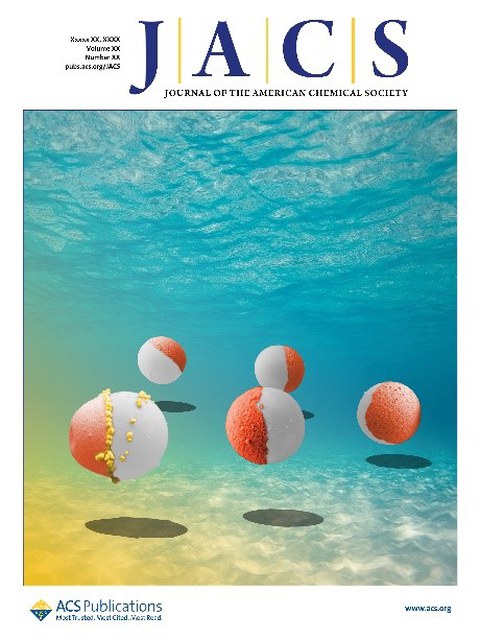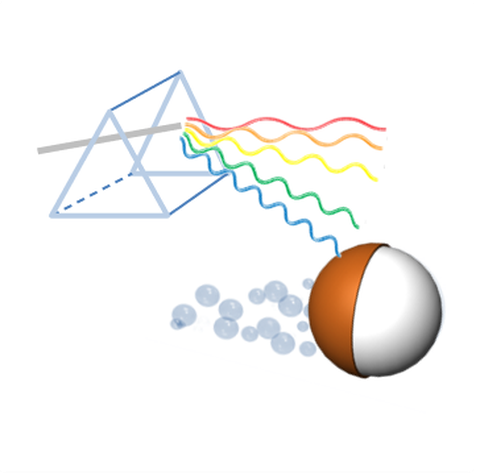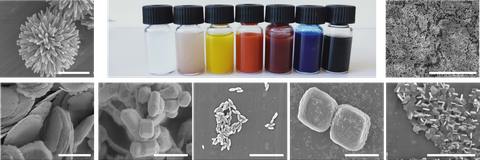Research in the Simmchen Group
Table of contents
Active matter
One of the most exciting new directions in colloidal soft matter is pushing colloids out of equilibrium, leading to self-propulsion.
A variety of different origins can be used to achieve energy dissipation in colloidal particles: catalytic reactions,[1] photocatalysis [2] or galvanic exchanges.[3] When energy is asymmetrically transferred between different forms, an active motility can be resulting. Whether the origin of asymmetry always has to come from distinct production steps, or it is possible to use inherent material properties instead is one of our current research questions. This property has been used to study different effects such as assembly[2] which will be crucial for upscaling effects towards applications. Especially the photocatalytic colloids open up a large variety of control modes beyond an on-off-switch, which sometimes leads to fascinating discoveries of phenomena, such as our recent work on apparent phototaxis.[4]
[1] Simmchen J, Katuri J, Uspal W, Popescu M, Tasinkevych M, Sanchez S, Topographical pathways guide chemical microswimmers, Nat Comm, 2016, 10598.
[2] Heckel S, Grauer J, Semmler M, Gemming Th, Loewen H, Liebchen B, Simmchen J, Active Assembly of Spheroidal Photocatalytic BiVO4 Microswimmers, Langmuir 2020, 36, 42, 12473–12480.
[3] Feuerstein L, Biermann CG, Xiao Z, Holm C, Simmchen J, Highly Efficient Active Colloids Driven by Galvanic Exchange Reactions, JACS 2021, 143, 41, 17015–17022.
[4] Niese L, Wang LL, Das S, Simmchen J, Apparent phototaxis enabled by Brownian Motion, Soft Matter 2020, 16, 10585-10590.
Biointerfacing of colloids
Colloidal particles are small entities that can consist of a variety of materials, which offers the possibility to tune a large variety of properties, ranging from geometry, density, catalytic activity, magnetic moment to surface charges.
Their interactions with biological entities are frequently determined by either the surface properties or the specific geometries. It is regularly observed, that nano- and microparticles attach to biological cells based on electrostatic interactions. One example attachment of differently charged colloids to sperm cells, that enable us to map the surface charges depending on the charge distribution. [5]
Furthermore, when these particles assemble in a permanent manner, they can confer properties to the biological entities that go beyond their natural abilities, leading to biohybrid microswimmers.[6,7,8] These are envisioned to gain increasing importance in biomedicine and drug delivery.[9]
[5] Magdanz V., Gebauer J., Sharan P., Eltoukhy S., Voigt D., Simmchen J. Sperm–particle interactions and their prospects for charge mapping. Advanced Biosystems 3,1900061 (2019).
[6] Stanton M. M., Simmchen J., Ma X., Miguel-López A. & Sánchez S. Biohybrid janus motors driven by Escherichia coli. Advanced Materials Interfaces 3, 1500505 (2016).
[7] Bastos-Arrieta J., Revilla-Guarinos A., Uspal W.E. & Simmchen J. Bacterial biohybrid microswimmers. Frontiers in Robotics and AI5,97 (2018).
[8] Magdanz V., Khalil ISM., Simmchen J. et al. IRONSperm: Sperm-templated soft magnetic microrobots. Science advances 6, eaba5855 (2020).
[9] Sonntag L, Simmchen J, Magdanz V, Nano-and Micromotors Designed for Cancer Therapy, Molecules, 2019, 24, 18: E3410.
Environmental nano- and microtechnology
Both, colloids and their microswimmers as their active cousins have attracted considerable scientific interest due to their potential in environmental remediation and circular economy.[10] However, the applications in biological and environmental fields are limited by the requirement of high energy fuels that are often toxic or oxidizing. Photocatalytic microswimmers are based on photocatalytic reactions. Benefitting from light as renewable energy and ‘green’ fuel (water), they extend the application potential in different fields, especially in environmental remediation. [11, 12]
[10] Safdar M, Simmchen J, Jänis J. Light-driven micro-and nanomotors for environmental remediation, Environmental Science Nano, 2017, 4, 1602-1616.
[11] Wang LL, Kaeppler A, Fischer D, Simmchen J, Photocatalytic TiO2 Micromotors for Removal of Microplastics and Suspended Matter, ACS AMI, 2019, 11, 3632937-32944.
[12] Chattopadhyay P, Sharan P, Berndt A, Simmchen J, Carbonate Micromotors for Treatment of Construction Effluents, Nanomaterials 2020, 10, 7, 1408.
(contact: Dr. Juliane Simmchen, Simmchen Group)



